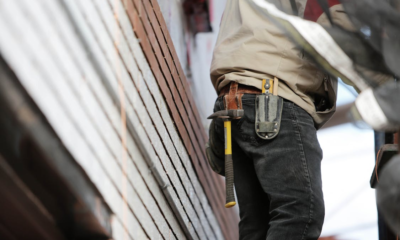Tech
A Step-by-Step Guide to Installing an Electric Vehicle Charger in Your Home
Published
1 year agoon

As electric vehicles (EVs) gain popularity, more and more homeowners are considering installing an electric vehicle charger at home. Having a dedicated charging station can provide convenience and peace of mind, ensuring your EV is ready to hit the road whenever you need it. In this step-by-step guide, we will walk you through the process of how to install an electric vehicle charger in your home.
Step 1: Assess Your Electrical Capacity
Before starting the installation process, you first must determine if your home’s electrical system can handle the additional load of an EV charger. Contact a licensed electrician to assess your electrical capacity and ensure that your electrical panel has the necessary capacity and infrastructure to accommodate the charger. Upgrading your electrical system may be required in some cases to ensure that you are not causing a potential fire hazard, especially if your home is over 20 years old.
Step 2: Choose the Right Charger
Consider your charging needs and select an EV charger that suits your requirements. There are different types of chargers available, including Level 1 (120V), Level 2 (240V), and Level 3 (DC Fast Chargers). Level 2 chargers are the most common for home installations, providing faster charging times compared to Level 1 chargers. Research various charger models to figure out which one you would like the best, considering factors such as charging speed, compatibility with your vehicle, and additional features like Wi-Fi connectivity or smart charging capabilities.
Step 3: Determine Installation Location
Identify the ideal location for your EV charger installation. It should be easily accessible, preferably near your parking space or garage. Ensure that the chosen location allows for proper ventilation and protection from the elements. Consider the length of the charging cable and the positioning of your vehicle when deciding on the installation spot.
Step 4: Obtain Permits and Local Approvals
Check with your local building department to determine if any permits or approvals are required for installing an EV charger. Some jurisdictions have specific regulations and codes that must be followed. Apply for the necessary permits and follow any guidelines provided to ensure compliance with local regulations.
Step 5: Hire a Licensed Electrician
Working with electricity requires expertise and knowledge of electrical codes and safety practices. It is strongly recommended to hire a licensed Idaho Falls electrician experienced in EV charger installations. They will handle the electrical wiring, connections, as well as ensure the installation meets safety standards and manufacturer specifications.
Step 6: Install the Charger
Once your electrician has assessed your electrical system and obtained the necessary permits, they will proceed with the installation. This typically involves mounting the charger on a wall or post, connecting it to the electrical panel, and routing the wiring from the panel to the charger. The electrician will carefully follow the manufacturer’s instructions, ensuring proper grounding and safe electrical connections.
Step 7: Perform Safety Checks and Testing
After the physical installation, the Idaho Falls electrician will conduct thorough safety checks and perform testing to ensure the charger is functioning correctly. This includes verifying proper electrical connections, testing the charger’s functionality, and confirming that the charging station communicates effectively with your EV.
Step 8: Educate Yourself on Charging Procedures
Once the charger is installed and operational, take the time to familiarize yourself with the charging procedures. Read the charger’s user manual, understand the different charging modes, and familiarize yourself with any additional features or smart charging capabilities. This will enable you to optimize charging efficiency and monitor your charging sessions effectively.
Installing an electric vehicle charger at home allows you to conveniently charge your EV and enjoy the benefits of emission-free transportation. However, it is crucial to approach the installation process with caution and hire a licensed electrician for the job. By following the steps outlined in this guide and seeking professional assistance, you can ensure a safe and efficient installation that meets local regulations and manufacturer specifications. Embrace the transition to electric mobility and enjoy the convenience of charging your electric vehicle from the comfort of your own home.
Recent News


4 Amazing Trips for Your Family
Choosing somewhere for a family vacation that would pique the attention of adults and kids alike can be a fun...


Customising Your Makeup with Blendable Blush Options
In cosmetics, one’s face is a canvas for self-expression and creativity. Among the myriad of products available, blush is a...


The Benefits of Regular Home Maintenance
Regular home maintenance is essential for maintaining and even raising the value of your house. A proactive approach to repairs...


Understanding the Importance of SEO in Adelaide
In the digital marketplace, Adelaide businesses are in a continuous contest to gain the attention of their target audiences. With...


Breaking Down the Numbers: Understanding the Average Traveling Nurses Pay
The open road, adventure, and the chance to heal – travel nursing promises an undeniable allure. But amidst the excitement,...


Dealing with Oily Skin in Summer: Tips and Tricks
As the temperature rises, those with oily skin often face an additional challenge—maintaining a clear and balanced complexion. Excess oil...


Mountain Wedding Ideas for 2024
A mountain wedding is a stunning choice for couples who cherish nature and desire a distinctive wedding experience. Whether you...


3 Of The Best Ways To Keep Your Salon Clean
It is of the utmost importance to ensure that a salon is kept scrupulously clean, not just for the sake...


3 Reasons You Should Get Blood Tests Every Year
Regular blood tests are essential for preserving general health and identifying potential problems early on. Medical professionals can evaluate your...


How to Make Your Next Crafts Project Pop
Crafting is a creative outlet that allows individuals to express themselves through various mediums such as paper crafts, sewing, painting,...
